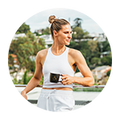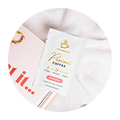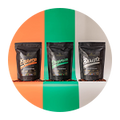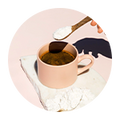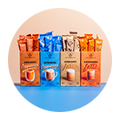Pilates has well and truly found its spotlight on social media—and while we love seeing it gain traction, it’s worth remembering that it’s not all about flashy moves and trending routines. We sat down with Nutritionist and qualified Pilates instructor Brianna-Lee, who has worked with everyone from rehab clients to pre- and post-natal mums, and she’ll be the first to tell you: the real power of Pilates lies in its foundations. Mastering the basics and coming back to them often isn’t just smart—it’s essential for building strength, control and longevity in your movement practice.
Before we dive into the exercises themselves, here are some important things to remember ⬇️
SPINAL POSITIONS:
Neutral spine is when your lower back has a natural arch and your tailbone is down.
Imprinted spine is when you utilise your abdominal muscles to pull your lower back towards the mat without lifting your tailbone. When both feet are lifted and unsupported, an imprinted spine activates the oblique muscles and supports the lower back.
BREATHING:
Pilates uses a particular breathing rhythm to facilitate movement and muscle activation. It is essential to exhale with every movement to provide muscle stability to the spine.
🫁 Inhale through your nose and direct your breathing to the sides of your rib cage.
🌬️ Exhale through your mouth, closing down the rib cage (think of magnets drawing your ribs towards your hips).
NECK AND SHOULDER POSITIONING:
To minimise unnecessary tension and neck strain, try and have your shoulder blades drawn down and back. Always begin with a neutral neck position, and remember to slightly tuck your chin. Don't poke it out and tuck your chin towards your chest - think double chin.

T -ZONE ACTIVATION A.K.A PELVIC FLOOR
Lay on your back with your knees bent and your feet flat on the mat. I want you to gently apply pressure with your index and middle fingers 1 cm in from your hip bone and keep them there. Next, I want you to imagine that you are drawing the letter "T" on the front of your pelvic. Begin by drawing a 'T' with the horizontal line running from hip bone to hip bone and the vertical line running up from the pubic bone to form the “T.” The vertical line represents your Pelvic Floor muscles, while the horizontal line represents your deep abdominal muscles. Imagine the vertical line to be like lifting your pelvic floor along that line as if you were stopping yourself from going to the toilet. Then, visualise drawing the hip bones over towards each other along the horizontal line, and then flattening that line in towards your spine. Continue to breathe normally. During our movements, we want to keep our T-Zone engaged.

BENT KNEE FALLOUTS
Lay on your back with your legs bent and your feet flat on the mat. Spine in neutral position. Relax your upper body and place your arms on each side of your body. T-zone on. Inhale as you lower one leg to the side, maintaining your pelvis steady and square to the ceiling. Exhale to draw the knee in. Alternate sides.

LEG SLIDES
Lay on your back, knees bent, feet hip distance apart, arms relaxed at your sides. Shoulders back and down. Spine in neutral position. Inhale lift up your pelvic floor. Exhale and slide one heel along the mat, extending your leg but keeping your knee soft. Inhale into the sides of your ribcage and hold. Exhale to bring the knee to its starting position by sliding the heel back. We want to imagine dragging our foot in thick mud. Keeping the pelvic floor lifted to maintain pelvic stability. Alternate sides.

LIFT AND EXTEND
Lay on your back with your knees bent and your feet flat on the mat. Relax your upper body and place your arms on each side of your body. T-zone engaged, spine imprinted. Inhale and lift one foot off the mat while keeping the pelvis and spine stable. Exhale and straighten the leg in front, keeping the foot off the mat and the knee soft. Maintain an imprinted spine and inhale to bend the knee and bring the leg back in. Exhale and return your foot to the mat. Repeat on the other side.

SINGLE LEG CIRCLES
Lay on your back, knees bent, and feet hip distance apart. Arms at your sides, shoulders back and down, and chin tucked in. Lift one leg to the ceiling, toes pointing, and extend it from the hip joint. Inhaling activates the T-Zone. Exhale and lower the leg to the floor through the center of the body. Inhale as you circle your leg to the side, around, and back up. Now exhale to return the foot to the mat. Then, on each side, repeat.

TABLE TOP
Lay on your back with bent knees and feet on the mat. Relax the upper body and place arms either side of the body. Inhale lift up through the pelvic floor. Exhale brings one knee at a time stacked on top of the hips. And repeat. If both legs are too challenging, just start by alternating sides to build strength.

TOE TAPS
Lay on your back with your spine imprinted and your legs hip distance apart in a tabletop position. Arms on the floor, sides relaxed, shoulder blades down and back. Look towards your knees with your chin slightly tucked. Inhaling activates the T-Zone. Exhale and lower one foot to the mat, tapping the toes. Inhale, and return the leg to the tabletop while maintaining a 90-degree angle. Repeat on the other side.

PELVIC CURLS
Lay on your back with your knees bent, your feet hip width apart, and your knees square with the ceiling. Arms at my sides, shoulders relaxed. Spine in neutral position. Inhale T-Zone and squeeze the glutes. Exhale and tuck the pubic bone towards the belly button, then roll the pelvis and spine up off the mat one vertebrae at a time, beginning with the tailbone and moving up to the shoulders, neutral spine at the top. Inhale and squeeze the glutes while holding the hips up. Exhale to imprint one vertebrae at a time back onto the mat. Think of your spine as a banana peel or a piece of sticky tape. Remember to draw through your heel and play around with the positioning of your feet to where you feel it in your glutes.

CLAMS
Lay on your side with the knees bent, feet back in line with the body, arm extended long under the head, head relaxed on the arm. A single long line should connect your hand, hip, and feet. Hips stacked on top of one other. Make a tiny gap between your waist and the floor (think of a tealight candle underneath your rib cage), and maintain a neutral spine. Inhale T-Zone, and squeeze the heels together and top glute. Exhale and open your top knee towards the ceiling, keeping your feet together and your hips forwards. Inhale to return the knee to its original position. We only want to move to hip height or below. Small, controlled motions. Repeat on both sides.

FLIGHT (HEAD UP)
On the mat, lay on your stomach with your legs straight and relaxed. Arms by the sides, palms facing up. You want to slightly tuck your chin in towards your chest and rest your forehead onto the mat. Maintain a neutral spine and tuck your pubic bone into the mat. As you inhale, bring your shoulders down and back, and lift your arms off the mat. If you don’t have any pre-existing neck issues, then lift your head and shoulders up. Otherwise just keep your forehead on the mat. Exhale to maintain this position and rotate your palms up and down. Keep breathing. Drop down when you need to rest.
You can do however many reps and sets of each exercise as you like, just as long as it feels good! You may even incorporate some as warm-up exercises prior to your other workouts. Have fun and feel that burn 🔥 - you'll thank me later 🫶🏼
